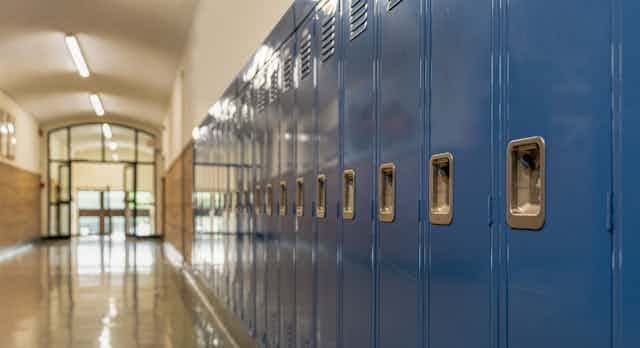Farewell to another school year. In Ontario, after a return to full activities with academics, clubs and teams after pandemic shutdowns, it seems that schools were constantly in the news for negative reasons.
The public heard about a lack of support for LGBTQ2S+ identities, chaotic and divisive school trustee meetings and a rise in violence in schools.
A major contributing factor to this rise in violence in schools is the chronic underfunding of public education and the social service sector. We need more infrastructure in communities that are economically neglected, often racialized communities.
In this challenging context, schools need to think hard about how they allocate resources and staff equitably, particularly now, at a time when they are approving their budgets for September.

Violence in schools
In the Toronto District School Board (TDSB), 323 students were involved in violence between September 2022 and April 2023, meaning the year has been on pace to set a new record by the end of the school year.
An alarming three-quarters (77 per cent) of members of the Elementary Teachers’ Federation of Ontario (ETFO), said they have “personally experienced violence or witnessed violence against another staff member” in a recent survey conducted by Strategic Communications. Survey results are based on a weighted sample of 24,872 ETFO members’ responses.
Black and other minoritized youth and educators are becoming collateral damage by being pushed out of schools due to wilful neglect of institutions in not supporting their needs. For students, the effects can be deadly: there have been 222 homicides of school-aged children (students up to age 21 years old) since 2007 in Toronto, with the victims and perpetrators predominantly Black.
The school-to-prison pipeline
The school-to-prison pipeline continues to cast a dark shadow over the education system in Ontario. This “pipeline” refers to the systematic processes that push students, particularly those from disadvantaged backgrounds, out of the educational system and into the criminal justice system.
This trend disproportionately affects marginalized communities, particularly Black and Indigenous students, perpetuating a cycle of poverty, systemic discrimination and mass incarceration.

Since that time, despite numerous reports commissioned and recommendations made by various stakeholders, little has been done to address the root causes of violence in schools and racialized communities. There is no national strategy to prevent violence and homicide largely impacting Black and racialized communities.
More policing and the tough-on-crime rhetoric is not the solution, particularly with a mayoral election happening soon in the City of Toronto.
Tragic impact on marginalized communities
The school-to-prison pipeline encompasses various interconnected factors including zero-tolerance punitive disciplinary practices in schools, over-policing of racialized communities, inadequate resources for students’ social and emotional well-being and a lack of alternative support systems.
This is a result of many institutions and leaders at all three levels of government collectively failing to support the needs of racialized communities.
Suspensions and expulsions disproportionately affect marginalized students. This is why as of 2020, Ontario’s Ministry of Education mandated no more suspensions for children from junior kindergarten to Grade 3.
Indigenous and Black people are disproportionately overrepresented in the criminal justice system. This disparity is rooted in systemic racism and a culture of institutional apathy which together perpetuates cycles of inequality, poverty and intergenerational trauma.
Calls to action
There needs to be long-term funding by all institutions to create infrastructure and access to timely and reflective social services for minoritized communities to mitigate and dismantle systemic inequities, such as the housing crisis and food insecurity, contributing to the rise in violence in schools. A comprehensive approach is necessary.
Meanwhile, schools and school boards need to plan for the future. Important considerations include:
1) Implement restorative justice practices within all institutions: Move away from punitive disciplinary measures and embrace restorative justice models that focus on repairing harm through trauma-informed and healing approaches.
2) Allocate staff and resources equitably: Ontario must prioritize funding for essential social services to address the root causes of students’ behavioural issues, ultimately preventing students being pushed into the criminal justice system. Redirect funds towards mental health services, counsellors, social workers and community programs that prioritize prevention and timely intervention.
3) Develop culturally responsive programs and services: Inclusive curricula and programs and services that reflect the histories, cultures and contributions of diverse communities matter.
This helps foster a sense of belonging and connection and reduces the likelihood of student and staff disengagement. There needs to be a more urgent implementation of the Truth and Reconciliation Commission of Canada’s 94 Calls to Action.
4) Establish community partnerships to mitigate risk factors during evenings and weekends: Forge collaborations between schools, community organizations and families to provide holistic supports and resources that address local community needs, particularly on evenings and weekends. Such community partnerships create continuity of care for children and youth.
At the end of April, Ontario’s Ministry of Education announced funding to combat violence and improving safety in schools through community partnerships. Such investments are critical.
Read more: Ontario can close students’ access and opportunity gaps with community-led projects
Yet, according to the Canadian Union of Public Employees, the provincial government has used accounting tricks to disguise what amounts to a cut in public school funding for 2023-24. Trustees with the Halton District School Board say there is a $20-million funding shortfall, and funds for 2023-24 won’t support important classroom programs.
If we do not systemically change our approach in how we support marginalized schools, students, parents and teachers, why are we surprised that the system keeps failing them? The effect of such failure is often the tragic outcome of death, being pushed out of schools or receiving a prison sentence.
We all have to do our part to hold institutions accountable, including for failures and neglect.

